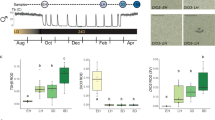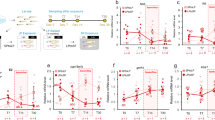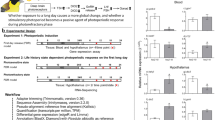Abstract
Molecular mechanisms regulating animal seasonal breeding in response to changing photoperiod are not well understood. Rapid induction of gene expression of thyroid-hormone-activating enzyme (type 2 deiodinase, DIO2) in the mediobasal hypothalamus (MBH) of the Japanese quail (Coturnix japonica) is the earliest event yet recorded in the photoperiodic signal transduction pathway. Here we show cascades of gene expression in the quail MBH associated with the initiation of photoinduced secretion of luteinizing hormone. We identified two waves of gene expression. The first was initiated about 14 h after dawn of the first long day and included increased thyrotrophin (TSH) β-subunit expression in the pars tuberalis; the second occurred approximately 4 h later and included increased expression of DIO2. Intracerebroventricular (ICV) administration of TSH to short-day quail stimulated gonadal growth and expression of DIO2 which was shown to be mediated through a TSH receptor–cyclic AMP (cAMP) signalling pathway. Increased TSH in the pars tuberalis therefore seems to trigger long-day photoinduced seasonal breeding.
This is a preview of subscription content, access via your institution
Access options
Subscribe to this journal
Receive 51 print issues and online access
$199.00 per year
only $3.90 per issue
Buy this article
- Purchase on Springer Link
- Instant access to full article PDF
Prices may be subject to local taxes which are calculated during checkout





Similar content being viewed by others
References
Dawson, A., King, V. M., Bentley, G. E. & Ball, G. F. Photoperiodic control of seasonality in birds. J. Biol. Rhythms 16, 365–380 (2001)
Nicholls, T. J., Follett, B. K. & Robinson, J. E. A photoperiodic response in gonadectomised Japanese quail exposed to a single long day. J. Endocrinol. 97, 121–126 (1983)
Follett, B. K., King, V. M. & Meddle, S. L. in Biological Rhythms and Photoperiodism in Plants (eds Lumsden, P. J. & Miller, A. J.) 231–242 (BIOS Scientific Publishers Ltd, Oxford, 1998)
Silver, R. et al. Coexpression of opsin- and VIP-like-immunoreactivity in CSF-contacting neurons of the avian brain. Cell Tissue Res. 253, 189–198 (1988)
Yasuo, S., Watanabe, M., Okabayashi, N., Ebihara, S. & Yoshimura, T. Circadian clock genes and photoperiodism: comprehensive analysis of clock genes expression in the mediobasal hypothalamus, the suprachiasmatic nucleus and the pineal gland of Japanese quail under various light schedules. Endocrinology 144, 3742–3748 (2003)
Sharp, P. J. & Follett, B. K. The effect of hypothalamic lesions on gonadotrophin release in Japanese quail (Coturnix coturnix japonica). Neuroendocrinology 5, 205–218 (1969)
Juss, T. S. in Avian Endocrinology (ed. Sharp, P. J.) 47–60 (Society for Endocrinology, Bristol, UK, 1993)
Yoshimura, T. et al. Light-induced hormone conversion of T4 to T3 regulates photoperiodic response of gonads in birds. Nature 426, 178–181 (2003)
Yasuo, S. et al. The reciprocal switching of two thyroid hormone-activating and -inactivating enzyme genes is involved in the photoperiodic gonadal response of Japanese quail. Endocrinology 146, 2551–2554 (2005)
Follett, B. K. & Nicholls, T. J. Acute effect of thyroid hormones in mimicking photoperiodically induced release of gonadotropins in Japanese quail. J. Comp. Physiol. B 157, 837–843 (1988)
Wada, M. Photoperiodic control of LH secretion in Japanese quail with special reference to the photoinducible phase. Gen. Comp. Endocrinol. 39, 141–149 (1979)
Ueda, H. R. et al. A transcription factor response element for gene expression during circadian night. Nature 418, 534–539 (2002)
Ganong, W. F. Circumventricular organs: definition and role in the regulation of endocrine and autonomic function. Clin. Exp. Pharmacol. Physiol. 27, 422–427 (2000)
Grommen, S. V. H. et al. Molecular cloning, tissue distribution, and ontogenic thyroidal expression of the chicken thyrotropin receptor. Endocrinology 147, 3943–3951 (2006)
Iwasawa, A. et al. Specific anti-peptide antibody to β subunit of chicken thyrotropin: production and characterization. J. Reprod. Dev. 48, 197–204 (2002)
Turnbull, A. V. & Rivier, C. L. Intracerebroventricular passive immunization. II. Intracerebroventricular infusion of neuropeptide antisera can inhibit neuropeptide signalling in peripheral tissues. Endocrinology 139, 128–136 (1998)
Maruyama, K. & Sugano, S. Oligo-capping: a simple method to replace the cap structure of eukaryotic mRNAs with oligoribonucleotides. Gene 138, 171–174 (1994)
Murakami, M. et al. Expression and regulation of type II iodothyronine deiodinase in human thyroid gland. Endocrinology 142, 2961–2967 (2001)
Panda, S. et al. Coordinated transcription of key pathways in the mouse by the circadian clock. Cell 109, 307–320 (2002)
Rebay, I., Silver, S. J. & Tootle, T. L. New vision from Eyes absent: transcription factors as enzymes. Trends Genet. 21, 163–171 (2005)
Matzuk, M. M., Kornmeier, C. M., Whitfield, G. K., Kourides, I. A. & Boime, I. The glycoprotein α-subunit is critical for secretion and stability of the human thyrotropin β-subunit. Mol. Endocrinol. 2, 95–100 (1988)
Sharp, P. J. Tanycyte and vascular patterns in the basal hypothalamus of Coturnix quail with reference to their possible neuroendocrine significance. Z. Zellforsch. Mikrosk. Anat. 127, 552–569 (1972)
Murakami, M. et al. Thyrotropin receptors in brown adipose tissue: thyrotropin stimulates type II iodothyroine deiodinase and uncoupling protein-1 in brown adipocytes. Endocrinology 142, 1195–1201 (2001)
Takagi, T. et al. Involvement of transforming growth factor α in the photoperiodic regulation of reproduction in birds. Endocrinology 148, 2788–2792 (2007)
Morgan, P. J. & Williams, L. M. The pars tuberalis of the pituitary: a gateway for neuroendocrine output. Rev. Reprod. 1, 153–161 (1996)
Wittkowski, W., Bockmann, J., Kreutz, M. R. & Bockers, T. M. Cell and molecular biology of the pars tuberalis of the pituitary. Int. Rev. Cytol. 185, 157–194 (1999)
Klosen, P. et al. The mt1 melatonin receptor and RORβ receptor are co-localized in specific TSH-immunoreactive cells in the pars tuberalis of the rat pituitary. J. Histochem. Cytochem. 50, 1647–1657 (2002)
Juss, T., Meddle, S. M., Servant, R. S. & King, V. M. Melatonin and photoperiodic time measurement in the Japanese quail (Coturnix coturnix japonica). Proc. R. Soc. Lond. B 254, 21–28 (1993)
Bockmann, J. et al. Thyrotropin expression in hypophyseal pars tuberalis-specific cells is 3,5,3′-triiodothyronine, thyrotropin-releasing hormone, and Pit-1 independent. Endocrinology 138, 1019–1028 (1997)
Wittkowski, W., Bergmann, M., Hoffmann, K. & Pera, F. Photoperiod-dependent changes in TSH-like immunoreactivity of cells in the hypophysial pars tuberalis of the Djungarian hamster, Phodopus sungorus. Cell Tissue Res. 251, 183–187 (1988)
Schaub, C., Bluet-Pajot, M. T., Szikla, G., Lornet, C. & Talairach, J. Distribution of growth hormone and thyroid-stimulating hormone in cerebrospinal fluid and pathological compartments in the central nervous system. J. Neurol. Sci. 31, 123–131 (1977)
Hojvat, S., Baker, G., Kirsteins, L. & Lawrence, A. M. TSH in the rat and monkey brain: distribution, characterization and effect of hypophysectomy. Neuroendocrinology 34, 327–332 (1982)
Bockmann, J., Winter, C., Wittkowski, W., Kreutz, M. R. & Bockers, T. M. Cloning and expression of a brain-derived TSH receptor. Biochem. Biophys. Res. Commun. 238, 173–178 (1997)
Crisanti, P. et al. The expression of thyrotropin receptor in the brain. Endocrinology 142, 812–822 (2001)
Lincoln, G. A., Clarke, I. J., Hut, R. A. & Hazlerigg, D. G. Characterizing a mammalian circannual pacemaker. Science 314, 1941–1944 (2006)
Krishnan, K. A., Proudman, J. A. & Bahr, J. M. Purification and partial characterization of isoforms of luteinizing hormone from the chicken pituitary gland. Comp. Biochem. Physiol. B 108, 253–264 (2004)
Yoshimura, T. et al. Molecular analysis of avian circadian clock genes. Brain Res. Mol. Brain Res. 78, 207–215 (2000)
Imai, Y., Matsushima, Y., Sugimura, T. & Terada, M. A simple and rapid method for generating a deletion by PCR. Nucleic Acids Res. 19, 2785 (1991)
Travnickova-Bendova, Z., Cermakian, N., Reppert, S. M. & Sassone-Corsi, P. Bimodal regulation of mPeriod promoters by CREB-dependent signalling and CLOCK/BMAL1 activity. Proc. Natl Acad. Sci. USA 99, 7728–7733 (2002)
Acknowledgements
We thank T. Kondo and the Nagoya University Radioisotope Centre for use of facilities. We also thank J. A. Proudman and A. F. Parlow for providing the chicken luteinizing hormone radioimmunoassay kit and the bovine TSH, respectively. This work was done as a part of the Program for Promotion of Basic Research Activities for Innovative Biosciences (PROBRAIN) and, in part, by Grant-in-Aid for Scientific Research (S), (B), Grant-in-Aid for Young Scientists (S), Grant-in-Aid for JSPS Fellows from the Japanese Society for the Promotion of Science, and a grant of the Genome Network Project from the Ministry of Education, Culture, Sports, Science and Technology of Japan.
Author Contributions T.Yo. conceived and directed the work. N.N., H.O., T.Ya., T.A., T.T., K.H., S.Y., Y.K., S.K., Y.U. and T.Yo. performed the microarray analysis and in situ hybridization. N.N., T.K., H.R.U. and T.Yo. analysed the microarray data. N.N. performed the quantitative PCR and promoter assay. M.I. and P.J.S. determined the luteinizing hormone assay. H.O. and M.I. performed the 125I-labelled TSH binding assay. T.Ya. and A.I. performed the immunocytochemistry. T.Ya., T.A. and A.I. examined the ICV injection and infusion. N.N., H.O., Y.S. and S.S. determined transcriptional start sites and genomic DNA sequences. T.Ni. cloned EYA, SIX and DACH family. M.M., T.Na. and S.E. provided laboratory facilities and new materials. All authors discussed the results and commented on the manuscript. T.Yo. and P.J.S. wrote the paper.
Author information
Authors and Affiliations
Corresponding author
Supplementary information
Supplementary Figures
This file contains Supplementary Figures 1-13 with Legends. (PDF 3230 kb)
Supplementary Tables
This file contains Supplementary Tables 1-5. (PDF 314 kb)
Rights and permissions
About this article
Cite this article
Nakao, N., Ono, H., Yamamura, T. et al. Thyrotrophin in the pars tuberalis triggers photoperiodic response. Nature 452, 317–322 (2008). https://doi.org/10.1038/nature06738
Received:
Accepted:
Issue Date:
DOI: https://doi.org/10.1038/nature06738
This article is cited by
-
Photoperiodic physiology of summer breeding birds and a search for the role of eye
Photochemical & Photobiological Sciences (2024)
-
Variation in responses to photoperiods and temperatures in Japanese medaka from different latitudes
Zoological Letters (2023)
-
Single-cell RNA sequencing revealed the liver heterogeneity between egg-laying duck and ceased-laying duck
BMC Genomics (2022)
-
Pars tuberalis as a key regulator of neuroendocrine functions
Nature Reviews Endocrinology (2022)
-
Hypothalamic remodeling of thyroid hormone signaling during hibernation in the arctic ground squirrel
Communications Biology (2022)
Comments
By submitting a comment you agree to abide by our Terms and Community Guidelines. If you find something abusive or that does not comply with our terms or guidelines please flag it as inappropriate.



